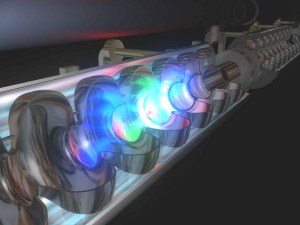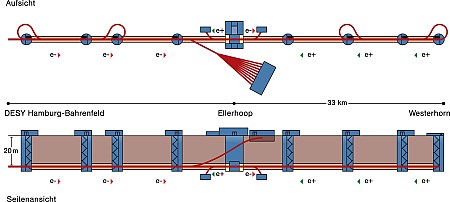Fig. 1 The TESLA line as planned
TESLA stands for "TeV-Energy Superconducting Linear Accelerator - a 33-kilometer-long superconducting particle accelerator with built-in X-ray lasers, which is being developed in an international collaboration. The special advantage of TESLA: an accelerator enables particle collisions at the highest possible energy levels and at the same time serves as a source of "hard" X-ray light with laser properties. The Technical Design Report (TDR) describes the scientific aims and potentials as well as the technical design of TESLA and has just been published.
TESLA - Project for the Future
An International Joint Project TESLA is DESY's project for the future. TESLA stands for 'TeV-Energy Superconducting Linear Accelerator' - a 33-kilometer-long superconducting particle accelerator with built-in X-ray lasers, which is being developed in an international collaboration. The special advantage of TESLA: an accelerator enables particle collisions at the highest possible energy levels and at the same time serves as a source of X-ray light with laser properties.
The collisions of electrons and positrons (their antiparticles) at previously unattained energy levels, make it possible that particle physicists have a deeper and closer insight into the structure and origin of matter and the universe, as ever before. Moreover TESLA comprises several so called free electron lasers with a special characteristic: They can generate extremely short and intense X-ray flashes with laser quality. Given the exceptional properties of the radiation produced by the X-ray lasers, TESLA will be perfectly equipped to create new research opportunities for disciplines such as physics, chemistry, biology, materials science and medicine. (...)
| whole article: |
Research at TESLA: Particle Physics and X-Ray Laser
Today, lasers deliver radiation of nearly every wavelength. However, there are still no high intensity lasers in the X-ray region, since the mirrors required do not exist. Yet, X-ray lasers are of special interest for science: For instance, they allow contrasty pictures of atomic structures to be taken in a way which is not possible today. A laser for X-ray radiation will open up new insights into the depths of living cells, molecules and materials.
Development work for the realization of a high intensity X-ray laser concentrates on so-called free electron lasers, which make use of the high energy particle beam coming from an accelerator. A sophisticated arrangement of magnetic fields forces the particles to follow a zigzag path, causing them to emit tightly focused laser-like radiation. Up to now, free electron lasers were only able to reach wavelenghts around 200 nanometers. Just like the "classical" lasers, they basically required a system of highly reflective mirrors between which the radiation is amplified. However, there are no suitable mirrors for radiation with wavelength below 150 nanometers - a novel procedure had to be found. The free electron laser at DESY is based on the SASE (self-amplified spontaneous emission) principle which works completely without any mirror and is thus especially well suited for the X-ray range.
The superconducting linear accelerator will propel tiny, spherical electron bunches to something approaching the speed of light. At the end of the accelerator, the electron bunches will pass through an undulator. This special arrangement of magnets - a sequence of alternating north and south poles - forces the electrons to follow a zigzag course. This induces them to emit a bright, coherent pulse of X-ray light, which moves somewhat faster than the electrons ahead and therefore soon catches up with them. When this occurs, some of the electrons are accelerated and others slowed down. As a result, the already tiny bunches become even more densely packed and radiate with an increasing intensity as they continue their journey through the undulator. They also exert a similar influence on other electron bunches. This effect is repeated until all of the electrons are oscillating in phase. At this point, the X-rays emitted overlap to form pulses of extremely intense laser light. (...)
|
| Further Information |








